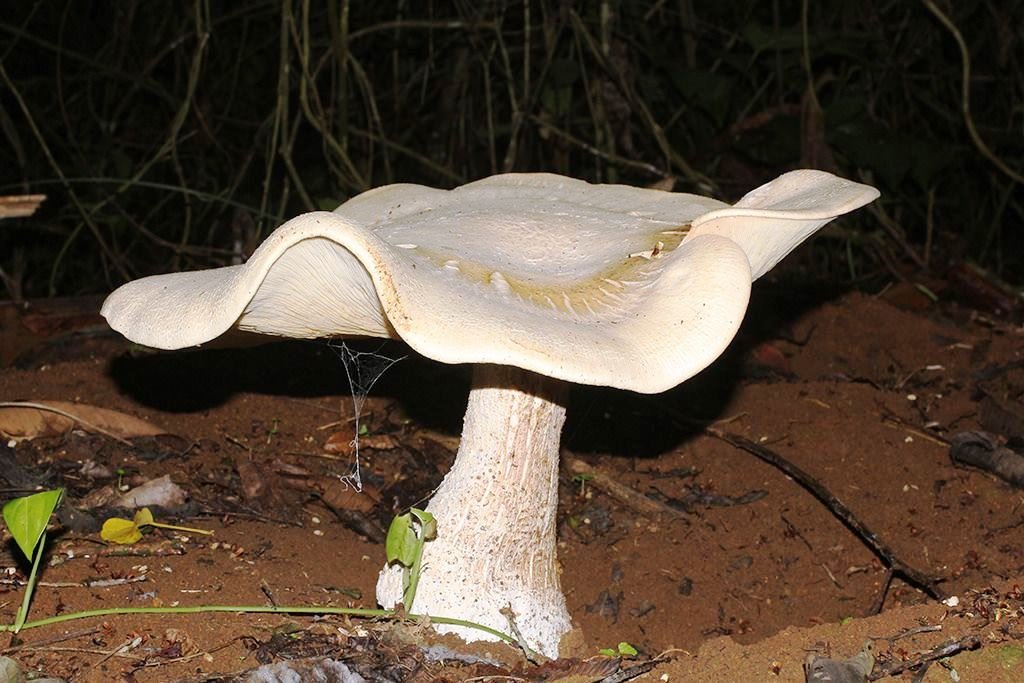General information:Common names: Macrocybe giganteaClass: Agaricomycetes Familly: Tricholomataceae Genus: Macrocybe Order: Agaricales Phylum: Basidiomycota Usable: Not edible |
Macrocybe titans physical characteristics
Macrocybe titans, also known as Macrocybe gigantea, is a large and impressive mushroom species belonging to the family Tricholomataceae.
Cap: The cap of Macrocybe titans is large, ranging from 10 to 40 centimeters (4 to 16 inches) in diameter. It is initially convex, becoming broadly convex or nearly flat as it matures. The cap surface is smooth and can have different colors, often ranging from white to cream, beige, or light brown.
Gills: The gills are closely spaced, narrow, and somewhat decurrent, meaning they extend slightly down the stem. They are initially white and become pale cream or light brown with age.
Stem: The stem of Macrocybe titans is thick, robust, and usually measures 10 to 30 centimeters (4 to 12 inches) in length and 2 to 4 centimeters (0.8 to 1.6 inches) in diameter. It is solid, sometimes with a hollow central cavity, and has a smooth or slightly fibrillose (fibrous) surface. The color of the stem can be similar to the cap or slightly darker.
Flesh: The flesh of Macrocybe titans is firm and thick. It is white or pale cream and does not change color significantly when exposed to air.
Spore Print: The spore print of Macrocybe titans is white.
Habitat: This mushroom species is typically found in tropical and subtropical regions, often growing in grassy areas, open fields, pastures, or lawns. It is also known to grow on roadsides and disturbed soil.
Edibility: Macrocybe titans is not widely considered edible and may even be toxic.
Macrocybe titans indentification
Identifying Macrocybe titans, requires careful observation of its physical characteristics.
Cap: The cap of Macrocybe titans is large and can range from 10 to 40 centimeters (4 to 16 inches) in diameter. It is initially convex, becoming broadly convex or nearly flat as it matures. The cap surface is smooth and can have various colors, often ranging from white to cream, beige, or light brown.
Gills: The gills are closely spaced, narrow, and somewhat decurrent, which means they extend slightly down the stem. They start out white and may become pale cream or light brown as the mushroom matures.
Stem: The stem is thick, robust, and usually measures 10 to 30 centimeters (4 to 12 inches) in length and 2 to 4 centimeters (0.8 to 1.6 inches) in diameter. It is solid, sometimes with a hollow central cavity, and has a smooth or slightly fibrillose (fibrous) surface. The color of the stem can be similar to the cap or slightly darker.
Flesh: The flesh of Macrocybe titans is firm and thick. It is white or pale cream and does not change color significantly when exposed to air.
Spore Print: The spore print of Macrocybe titans is white.
Macrocybe titans habitat and frequency, fruiting season and locations
Macrocybe titans, is a mushroom species typically found in tropical and subtropical regions.
Habitat: Macrocybe titans is commonly found in grassy areas, open fields, pastures, lawns, and other disturbed habitats. It is known to grow on roadsides and in areas with rich, organic soil. This mushroom species has a preference for warm and humid environments, typical of tropical and subtropical regions.
Frequency: The frequency of Macrocybe titans can vary depending on the local environmental conditions. It is considered relatively common in its preferred habitats, especially during the rainy season when conditions are favorable for its growth.
Fruiting Season: In tropical and subtropical regions, Macrocybe titans typically fruits during the rainy season or the wetter months. The exact fruiting season may vary depending on the specific location and climate conditions. In some regions, it may be observed fruiting from late spring to autumn.
Locations: Macrocybe titans is primarily found in tropical and subtropical regions of the world. It has been reported in various countries, including parts of Southeast Asia, Central America, South America, and some islands in the Pacific Ocean. Specific locations where Macrocybe titans can be found include countries like India, Indonesia, Malaysia, the Philippines, Thailand, Brazil, and Costa Rica, among others.
Macrocybe titans scientific research
Macrocybe titans is known by several names, including Macrocybe gigantea, and research under both names might be relevant.
Some scientific research on Macrocybe titans includes studies on its taxonomy, morphological characteristics, and distribution. Researchers have also explored the ecological role of this mushroom species, particularly in relation to its habitat preferences and interactions with other organisms.
Additionally, there might be studies focused on the potential medicinal properties of Macrocybe titans or other related aspects, although these may be less common compared to research on more commercially significant or widely studied mushrooms.
Macrocybe titans other names
Macrocybe gigantea
Giant Macrolepiota
Giant Parasol
Malay Umbrella
Philippine Straw Hat
Jumbo Mushroom
Straw Mushroom
In other Languages:
Spanish: Macrocybe titans or Macrocybe gigantea (same as in English)
French: Macrocybe titans or Macrocybe géant (giant Macrocybe)
German: Riesenschirmling (giant parasol)
Italian: Macrocybe titans or Macrocybe gigantea (same as in English)
Portuguese: Macrocybe titans or Macrocybe gigantea (same as in English)
Dutch: Reuzenparasolzwam (giant parasol mushroom)
Swedish: Jättetaggsvamp (giant shield mushroom)
References
(H. E. Bigelow & Kimbrough, 1980) Pegler, Lodge & Nakasone, 1998. (Bigelow & Kimbrough, 1980; Pegler, Lodge & Nakasone, 1998; Halling & Mueller, 2004; Bessette et al., 2007; Elliott & Stephenson, 2018; Karlsen-Ayala & Smith, 2020.)
